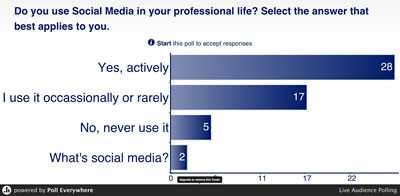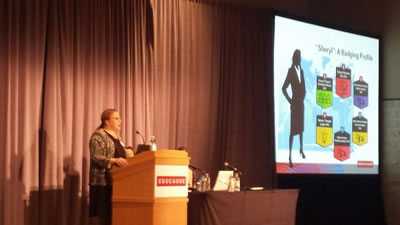10 of the hottest disruptive technologies in higher education, as revealed by EDUCAUSE and enthusiastic CIOs
 The annual EDUCAUSE conference is where innovative higher education CIOs go to learn about new industry trends and compare notes on the latest breakthroughs.
The annual EDUCAUSE conference is where innovative higher education CIOs go to learn about new industry trends and compare notes on the latest breakthroughs.
This year was no exception as 7,300 IT leaders from more than 50 countries gathered in Orlando along with 260 educational technology exhibitors. Discussions took place in session rooms, on the exhibition floor, after the keynotes, and throughout the hallways.
These are the common threads that permeated those discussions; the ten hottest topics for CIOs in higher education:
View the slideshow!
[field name=iframe2]
1. Campus Wi-Fi
It is now universally understood that the quality of the student computing experience has become an important decision factor for students in selecting a college. The challenge is to provide Wi-Fi density and coverage to adequately accommodate the three or more devices, many of them streaming, that each student is bringing on campus. This burgeoning demand for Wi-Fi on campus is severely taxing the IT infrastructure. Residence hall Wi-Fi can get congested quickly, so wired access is often used to provide bandwidth relief for devices like gaming consoles. Many schools have started to charge an extra fee to charge uber users who consume more than 20GB per week. When it comes to guest Wi-Fi access, schools run the gamut of open-connection, charging for use, sponsored guest access, or a combination of these. Here are 50 incredible WiFi market trends and statistics that are truly staggering.
The Campus Computing Project’s 2014 survey was revealed at the conference and reported that senior higher education IT officers identify “implementing/supporting mobile computing” as a top IT priority, yet only 17 percent rate mobile services at their institution as “excellent.” One informal poll at the conference showed that about 30 percent of schools are in the process of migrating to the latest Wi-Fi standard, 802.11ac.
Strategic CIOs in higher education are investing in WiFi infrastructure to improve the student, faculty and administration’s overall campus experience.
(Next page: Being social, digital badges, analytics, and more)
2. The Importance Of Being Social

Social media is a game changer for higher education CIOs. Social media is taking on a growing role at EDUCAUSE and throughout higher education. Here is a list of the top 50 social higher education CIOs on Twitter. There was more live tweeting this year than ever before. The social media feeds enabled attendees and even those unable to attend to have a virtual presence, absorbing content from across the conference. The social media feeds were captured on Storify: #EDU14 Daily Wrap-up day 2 and#EDU14 Daily Wrap-up day 1.
The session “CIOs Sound Off: To Be or Not to Be ‘Social'” provided a point-counterpoint discussion of the pros and cons of social media for university CIOs. The audience actively participated via Twitter (#EDU14socialcio, captured on Storify) and interactive poll questions, and provided crowd-sourced tips for more effective use of social media in higher education.

3. Digital Badges
Digital badges as validated indicators of specific competencies and their connection to competency-based education were heavily discussed at EDUCAUSE 2014. Just before the conference, EDUCAUSE published the 7 Things You Should Know About Badging For Professional Development. As another indicator of the growing significance of digital badges, 60 percent of the 1,900 people who participated in the Extreme Networks digital badge survey believe that badges will either entirely replace diplomas and course certificates, or be used in combination with them. I recently published a presentation about the use of digital badges to improve employee engagement.

4. Business Analytics
The use of analytics as a means to drive critical institutional outcomes has grown rapidly as the associated technology has improved. This year there were no less than seven panels and 26 sessions dealing with learning analytics, data-driven decision making, and predictive analytics at the EDUCAUSE conference. The session, “Analytics That Inform: The University Challenge,” articulated the different contexts for analytics in education. Two analogies were made: one with business intelligence, now a $15B market, and one with physician diagnostic tools. There is general agreement on the need to present student analytics in the form of a dashboard, for use by both administration and students. Such a dashboard can help improve student outcomes as well as improve student retention.
In addition to student analytics, another type of campus analytics relates to network infrastructure. Presenters from Fontys Hogescholen described how they use network analytics to track student activities across the campus and are able to correlate demographic data with behavior and even effect change.
5. Google Glass and Wearables
The session, “Prepare to Wear! Exploring Wearable Technologies in the Learning Environment,” generated phenomenal enthusiasm and discussions that carried well past the conference. Many of the 14 Google Glass Innovative Uses In Education that I wrote about with Brian Rellinger earlier this year were in evidence. It is clear that all types of wearable computers, including Google Glass, fitness bands, clothing, fashion wearables, and the forthcoming Meta holographic eyewear will have a dramatic impact on higher education.
6. Drones
Drones are finding growing usage in education. Colgate University’s poster session, “Just Don’t Call It a Drone,” showed how to use hobbyist quadcopters and Arduino technology in student research programs to capture photography and other environmental observations. The project had amazing results for both learners and researchers. I predict there will be more sessions on this topic next year, as drones find many new uses within higher education (see my blog, 10 Uses of Drones in Higher Education [Slideshare]).
(Next page: Topics 7-10)
7. 3D Printing
As listed in the description of one of sessions on the topic, “the era of 3D printing has arrived.” For those eager to enter this era, a number of sessions and exhibition demonstrations showed how to integrate 3D printing, and complementary 3D scanning, into the curriculum. Popularity of the printers is highest in art, design and engineering programs. Many schools are acquiring one high-end consumer-grade or low-end enterprise-grade 3D printer per department. Stay tuned as prices of consumer 3D printers are likely to be aggressively driven downward.
8. Digital Courseware
The two emerging aspects of digital courseware are Competency-Based Education (CBE) and Adaptive Learning. The concept behind CBE is to enable students to master skills and knowledge at their own pace, via multiple pathways that generally make better use of technology. The Bill and Melinda Gates Foundation had a hand in elevating the topic this year with a $20M investment in next generation courseware related to adaptive learning and CBE. Last year, a similar grant gave a major boost to Integrated Planning and Advisory Services (IPAS).
CBE can help meet the needs of all students regardless of their learning abilities, and can lead to more efficient student outcomes. With CBE, students earn competency units rather than credit hours. So far, large community colleges have taken a leadership role in the field.
Adaptive learning, closely related to CBE, is an educational method that uses computers and electronic text books as interactive teaching devices. The presentation of educational material is dynamically adapted to students’ learning needs, as indicated by their responses to questions and tasks as they progress.
A number of young CBE and adaptive learning technology vendors demonstrated their wares during EDUCAUSE 2014, including Flat World Education, eLumen (demo), Regent Education (presentation), Pathbrite, Public Agenda, CCKF, and Acrobatiq. Many of these vendors emphasize a mobile-first approach. The feedback from Salt Lake Community College and the University System of Georgia highlighted the need for integration with existing products, comprehensive dashboards, and a mechanism for social interaction. Schools in general are watching to see what kind of results adaptive learning generates.
9. Small Private Online Courses (SPOCs)
This is the year that Massive Open Online Courses (MOOCs) lost the limelight. The issue is the extremely low completion rates of students who sign up for MOOCs. A Gartner poster of the education hype cycle that was on display at EDUCAUSE marked MOOC as “obsolete before plateau.” The Campus Survey 2014 noted that less than two-fifths of the survey respondents now agree that MOOCs offer a viable model for the effective delivery of online instruction, down from 53 percent in the fall of 2013.
Clayton Christensen did not mention “MOOC” even once during his opening keynote, though the best known MOOCs, EDx and Coursera, had often been considered as disruptive to higher education. It is now realized that MOOCs lack most of the markers for disruptive innovation; they do not target non-consumers and they lack a viable business model. On the other hand, the Christensen Institute does believe that CBE may prove to be disruptive.
Picking up where MOOCs left off is the concept of Small Private Online Courses (SPOCs); these were discussed at the one MOOC conference session. This session also discussed the future of MOOCs for advanced placement courses, remedial classes, professional development, and to serve the community. More importantly, the technology infrastructure created by the MOOC providers like EDx, Kahn Academy and Coursera will very likely provide the platform for the full range of online courses into the future.
10. Virtual Reality
Immersive and augmented reality have the ability to completely re-invent education. When ready for general use, products like Oculus Rift and Magic Leap are capable of transporting the student to almost any learning environment imaginable. As with many emerging educational technologies, virtual reality has application both to higher education and K-12 education. At the ISTE K-12 conference earlier this year, there were no less than 14 sessions discussing how to apply VR in education. The technology enables students to travel with their professors to any virtual learning environment imaginable: far-off lands and planets, inside the atom, ancient civilizations, to the beginning of the universe. On a limited scale, some of these capabilities are already here. At the rate the technology is progressing, VR could be fully integrated into our teaching within five years.
Vala Afshar is the Chief Marketing Officer for Extreme Networks. Afshar is the author of The Pursuit of Social Business Excellence. This post was co-authored by Robert Nilsson, director of marketing at Extreme Networks. This article first appeared in Huffington Post.

